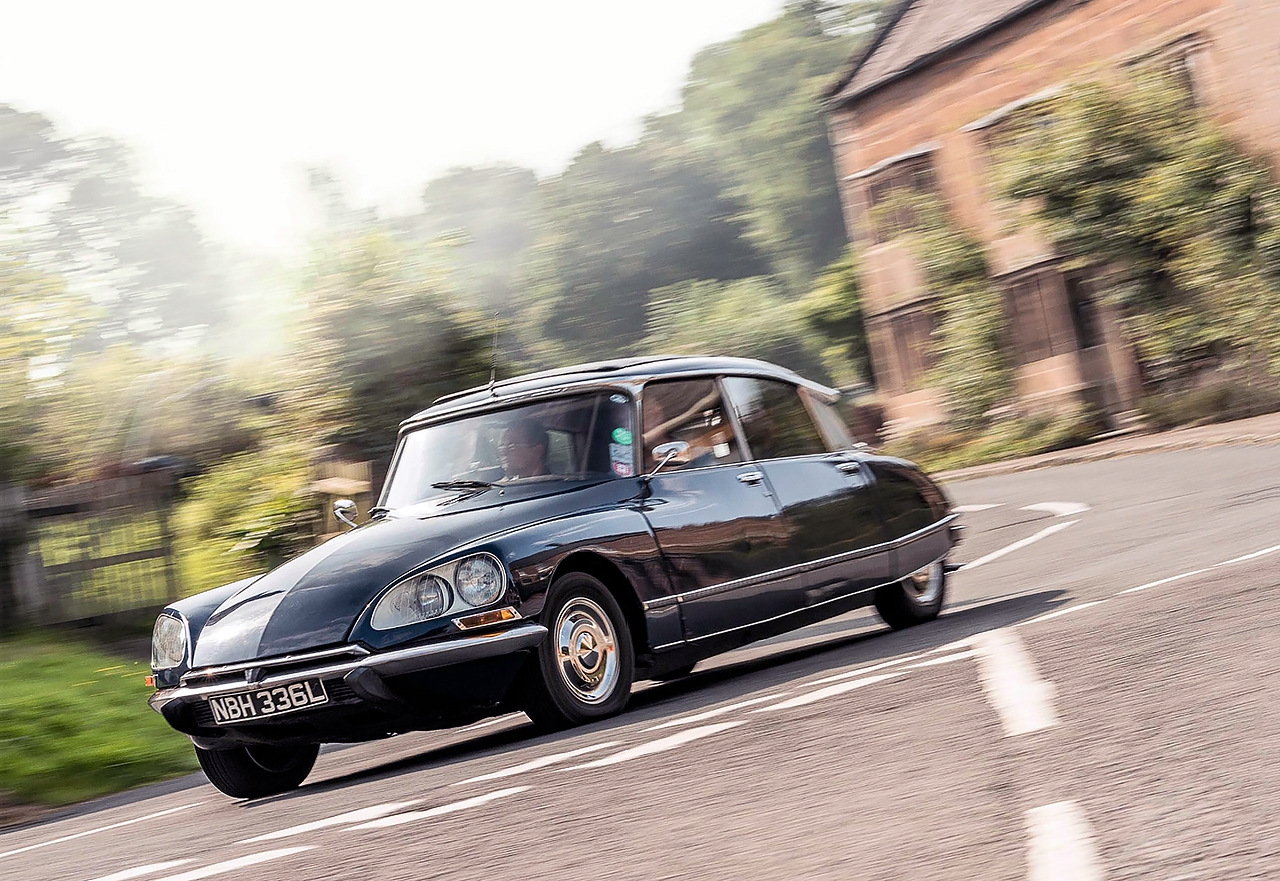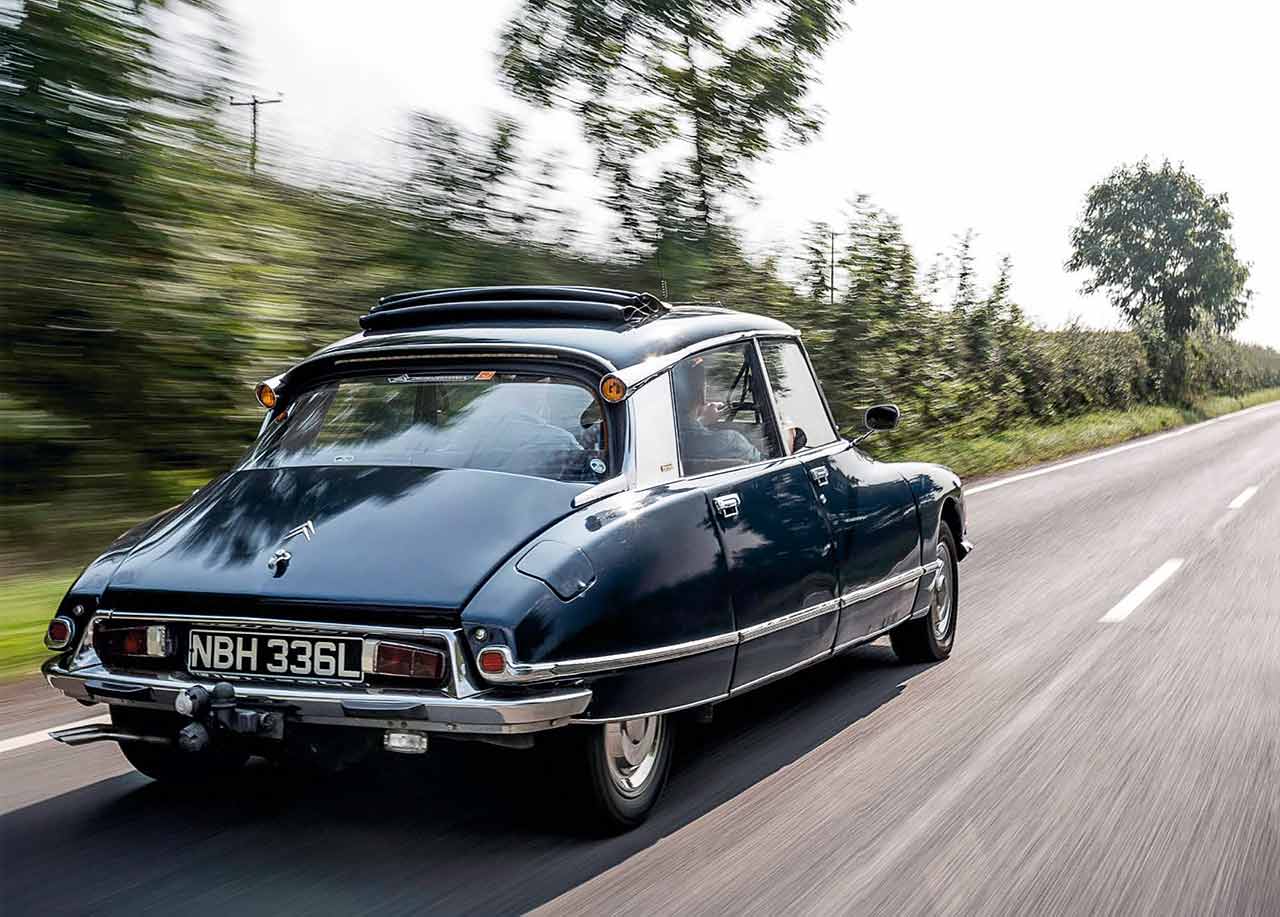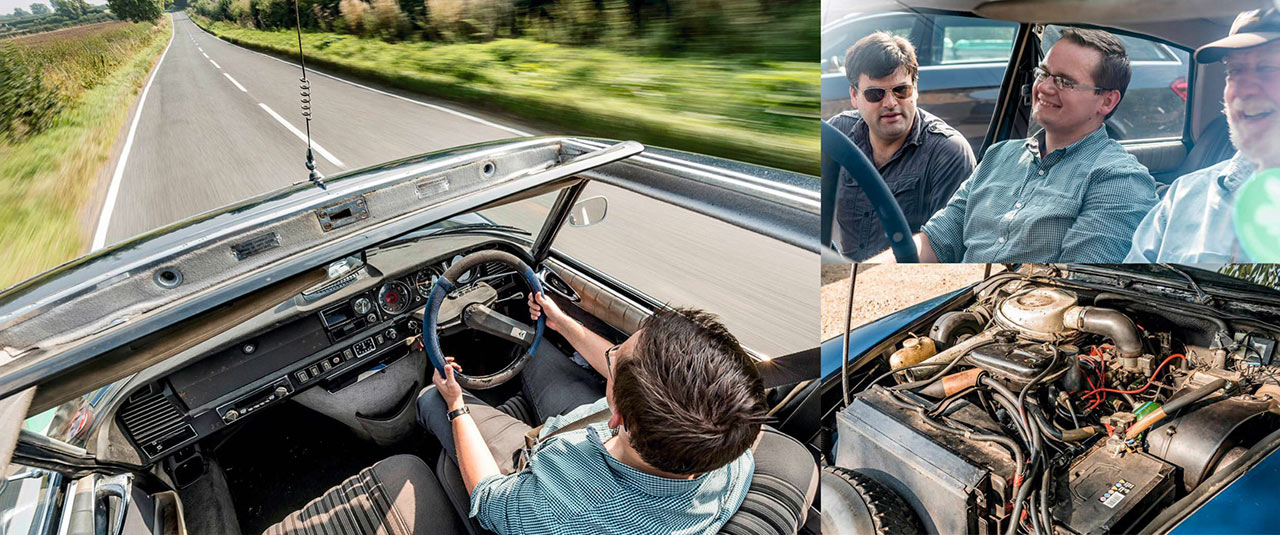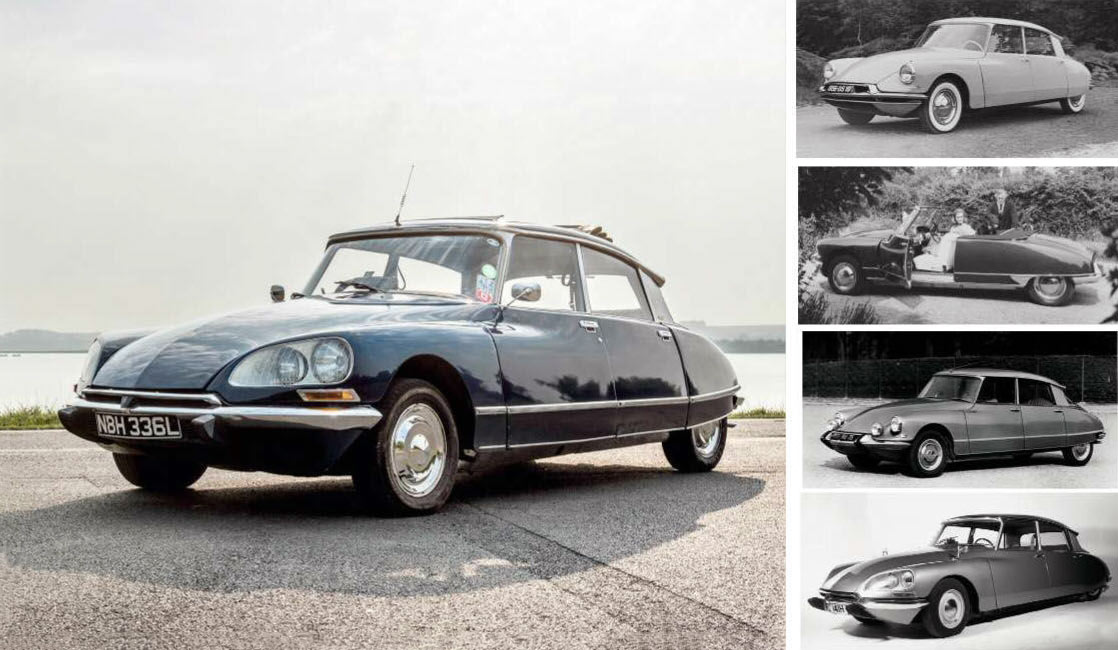
The List. The Citroën DS was a magazine pin-up for reader Lukasz Stankiewicz living in Eighties Poland. How does driving the real thing stack up against his long-held dream? Lukasz expected the smoothness of the DS ride, but the swiftness of the 2.3-litre engine was a surprise. When Lukasz Stankiewicz was growing up in Eighties Poland the Citroën DS23 was an exotic car glimpsed in magazine photographs. Three decades later we give him the chance to compare fantasy with reality. Words Sam Dawson. Photography Alex Tapley.
The List
1961 Lincoln Continental ‘A standard-setting luxury saloon, possibly better than its more obvious competitors.’
Facel Vega HK500 ‘More expensive than a Rolls-Royce, yet it had a Chrysler V8. Could modern manufacturers learn from it?’
Maserati Quattroporte I ‘There’s no point in trying to hide my love of V8-engined luxury saloons.’
Pierce-Arrow Silver Arrow ‘One of the greatest luxury cars. It killed the company, but must have been wonderful.’
Jaguar MkX ‘This is how all Jaguars should be, even today.’
Meeting Classic Cars reader Lukasz Stankiewicz in a car park on the outskirts of Market Harborough, I get the impression that he spent the previous night memorising facts about the Citroën DS, the dream car he’s about to drive with a little help from Classic Cars. ‘It’s amazing how much space they managed to fit into such a relatively compact car, isn’t it?’ he asks, pacing around the DS23 Pallas that Alan Kemp has owned for more than 20 years. ‘It’s still fairly long but with a wheel right at each corner they managed to make it huge inside while avoiding any unwieldiness. And then, of course, there’s the hydropneumatic system,’ he says, marvelling at the alien-green-painted modules and relays nestling among the more conventional engine-bay items. He can’t stop asking Alan technical questions – ‘What is the length of the wheelbase in relation to the body?’; ‘What’s the difference between the front and rear track?’; ‘What effect does it have on the handling?’

1971 Citroën DS23 Pallas road test
Thanks to its avant-garde styling and logical yet unique approach to engineering, the DS has always been popular with those who consider themselves outside of the classic car mainstream, but Lukasz’s perspective is somewhat unusual. ‘No Citroëns came to Poland before the fall of the Berlin Wall,’ he says. ‘My father subscribed to car magazines in the Eighties, and when he’d finished reading them he’d hand them to me and I’d cut out the photos of my favourites. Most of the cars featured were from the Soviet bloc, but there were some reports on German cars – Poles love German cars, by the way; Volkswagen was the first to establish itself in Poland post-communism – but I remember seeing a photo of a Citroën BX when I was a kid and thinking there must be something wrong with it, what with it sitting so low. It made Citroëns seem exotic.
‘I know it sounds odd calling a Citroën BX “exotic”’, Lukasz laughs, ‘but it’s all down to that sense of difference. If you look at photos of pretty much any Polish wedding from the Sixties and Seventies, you’ll inevitably see an American car in the background, usually a Cadillac. Imports were officially restricted under the Soviets, but there were always people with the right connections who could get them into the country. Still, it gives you an idea of the kind of luxury car you’d find in Poland back then. It wouldn’t involve front-drive or hydropneumatic suspension.
‘And then one day in 1994 I was out walking my dog around my home town of Suwalki – it’s a little place in the north-east near the Lithuanian border, tourists don’t often make it there – when I first saw a Citroën DS. It was on French plates and had clearly been driven all the way from France. The first big Citroën to be sold in Poland was the Xantia – it was quite conventional and didn’t make much impact on the sales of German rivals – but this DS was magical, completely different from any other car I’d ever seen. I spent ages just staring at it, walking round it. The owner never showed up, but I wouldn’t have stopped asking questions.’
Now Lukasz’s overt fascination with the DS’s finer details makes perfect sense. He’s wanted answers ever since he was a schoolboy.
Lukasz settles into the driver’s seat, having admired the frameless windows en route, making a point of winding them all down and running his fingers along the uninterrupted line from A to C pillar. ‘I’m amazed by the seats,’ he says. ‘They’re very soft – totally different from the modern German idea of luxury with lots of firm leather – but they’re not shapeless either. You sink into them and that holds you in place, no need for hard bolsters. It’s a very comfortable solution, like a Tempur mattress.’ As Alan closes the driver’s door, he demonstrates another of the DS’s refinements, often overlooked. ‘Zero-torque locks,’ he says, pushing the door closed with a fingertip tap. ‘No force needed to shut the latches.’
And yet, amid all this comfort, Lukasz is still feeling nervous. He’s sitting at the wheel, but he’s well aware that the controls of a Citroën DS are alien to anyone who’s grown used to a traditional three-pedal manual set-up. He tentatively gestures to the pedal on the left of the footwell and asks: ‘Er… Alan, is that the brake?’
Alan laughs as he climbs into the front passenger seat. ‘No. Well, yes, it’s the parking brake, but the brake you’re looking for is that black rubber button on the floor. You squeeze it rather than pushing it – the main thing is to be gentle.’
Lukasz fires up the engine by moving the thin column-mounted gearlever from its ‘Park’ position, and the car rises gently to its intermediate cruising-height setting on its hydropneumatic spheres, feeling a little like a motor launch bobbing at the end of a jetty. He takes a few attempts to find first gear, selected by pushing the lever away towards the speedometer, before pulling tentatively away and working his way through the linear gear pattern across the dashboard, trying not to press the parking-brake pedal in lieu of a clutch. There’s no need for such an action anyway – the clutch is hydraulically actuated by the movement of the lever.
Progress is jerky at first. ‘The brake is so sensitive!’ Lukasz exclaims as the car lurches forward, bouncing on its gas-and-oil sphere suspension. He’s attempting to decelerate as we head downhill towards the village of Sutton Bassett. To the novice, slowing a DS that’s gathered pace on a sweeping cross-country route is daunting – those long gear ratios baulk sharply if you shift down too early, even though Citroën incorporated a hydraulic idle-adjuster into the hydropneumatic system to smooth the transition between gears. To add to the challenge, the famously smooth DS will protest if you don’t have much experience of metering pressure in micron-thin increments through the no-travel brake-button.
‘I feel like I did when I drove for the first time!’ says Lukasz. ‘But the car is trying to help with its smoothness, even though I’m an amateur when it comes to operating these controls. I must admit, I was expecting it to be slow – I know the 1.9-litre DS19 has a reputation for being sluggish – but this 2.3-litre version gathers speed quite deceptively. The smoothness of its ride and upchanges on the gearbox make it feel more sedate than it actually is, so you only realise how much speed you’ve been carrying when you absolutely have to slow down. I feel I need to practise braking and slowing down in this car – it’s more of a handful than I was expecting in those situations, but eventually I’ll work out how to do it properly.’
The expansive B664 is deserted, so we can concentrate on effortless cruising. ‘I keep having to remind myself that this is essentially a Fifties car, even though this one is from 1971, because it was still ahead of its time even when they replaced it with the CX,’ muses Lukasz. ‘It’s not just the obvious things – the suspension, the aerodynamics, the high-level indicator lights, the frameless doors – it’s little details that are only obvious if you ask an expert, like the door latches or 12-volt electrics. Those American cars I remember from my childhood, even with their luxury specifications, only had six-volt systems even up to the early Eighties. And the way the gearbox works reminds me of a modern dual-clutch system, even though I’m old-school and prefer a conventional torque-converter automatic. I think that I prefer the Citroën’s laid-back shift to a fast modern DSG anyway.’
We pull over in the village of Weston by Welland, because Lukasz wants to satisfy a curiosity piqued by the original dealer-fit Webasto roof. ‘Can we take the roof off?’ he asks. ‘I’m not necessarily a fan of the Décapotable [the glamorous Chapron-bodied DS convertible] because I feel luxury four-seaters should have four doors, but it would be interesting to see how it changes the driving experience.’
We’re lucky it’s sunny in rural Leicestershire today, because peeling back the Webasto exposes most of the cabin to the open air. Chapron produced the four-door Découvrable in even smaller numbers than the Décapotable for State use, although its folding roof extended to the base of the C-pillars. The effect of the Webasto is similar – and at least Lukasz can still see through the rear windscreen of this one.
‘After getting stressed out on the M25 this morning on the way here, it’s so relaxing to drive like this,’ he says.’ I know I’m stuck in the past – I am a classic car enthusiast in his thirties after all – but when I’m trying to have a relaxing drive in my Jaguar S-type, even seeing the satnav screen in my peripheral vision annoys me.
Here in the DS, there are no distractions, it’s almost like we’re gliding. I feel as though the car is encouraging me to enjoy my surroundings. I realise it’s not a fast car, especially compared to the V8 Jaguars that I’m used to, but that doesn’t matter. It makes the journey itself more satisfying, and you can’t enjoy that if you’re going too fast. By contrast, I recently borrowed an XKR for a few days and found it annoying – so much power, yet on UK roads there’s nowhere to put it down. I’m amazed quite how much the Webasto roof transforms the drive. The sun and the rolling hills actually remind me of driving in Tuscany.’
After a few moments of silent contemplation, Lukasz pulls over unexpectedly. ‘I know this sounds odd,’ he says, ‘but I’d like to experience this car from the back seat. I get the impression that’s what it’s all about – travelling rather than driving.’
He sinks into the pillowy rear seat, prodding his brogues into the two-inch-deep foam-underlaid carpet as Alan takes over driving duties. ‘It’s so comfy, I feel like sprawling across it, it’s like a sofa,’ Lukasz marvels. ‘So many cars, both classic and modern, are designed as drivers’ cars, but Citroën was clearly thinking just as much about the passenger experience when it designed the DS. It’s actually easier to concentrate on the things that make the car so comfortable from back here – the way the hydropneumatic system works to keep things smooth, the way the suspension stays level. And the view, especially with the roof back, is incredible.’
We pull over at the Nevill Arms in Medbourne for a pint in the beer garden and to consider the DS in isolation. ‘Would I like my own DS?’ Lukasz ponders. ‘ I’d certainly like to borrow one for a week and take it on holiday. However, even though the four-cylinder engine is faster than I thought – the responsiveness of the carburettor helps – it’s not quite effortless enough to suit the car. It’s such a pity that the flat-six that Citroën wanted for the car never went into production. I never thought that I would be, but I am a big-engine man. I’m an accountant by profession, but during university summer holidays I went to the US, worked as a croupier in casinos and ran an old V8-engined Buick LeSabre. That turned me on to the idea of torque and low-down power, and since then I’ve owned Jaguars. I used to work for Jaguar in product development and feel it’s a shame that so many of its cars are diesels nowadays. No matter how they’re developed, they just don’t have the refinement of a big petrol-powered V-engine. That’s what the DS needs.
‘But I do feel I need a big Citroën in my life. I’d like to try the Citroen SM, Citroen CX, Citroen XM and Citroen C6 to make up my mind.’
As we finish our pints and say our goodbyes, Lukasz is making a note of the next big Citroën Car Club meeting. I have a feeling they’ll have a new member sometime soon.
‘It feels like when I drove for the first time… but the car is trying to help me’

For Lukasz, driving the DS answered questions he’d wanted to ask since seeing photos of Citroëns as a child. Lukasz (centre) reveals to writer Sam (left) that he’d like to try a session as a back-seat driver. It may be better than he expected, but the four-cylinder is still too short on low-down grunt for Lukasz’s liking. DS defines French creativity. Dealer-it Webasto roof offers an enhanced view of the English countryside.
TECHNICAL DATA 1971 Citroën DS23 Pallas
Engine 2347cc in-line four-cylinder, ohv, Weber DMA2 carburettor
Power and torque 124bhp @ 5500rpm; 135lb ft @ 3500rpm
Transmission Four-speed manual with automatic clutch (Semiautomatic Citroen build), front-wheel drive
Steering Hydraulically assisted rack-and-pinion
Suspension Front: independent, wishbones, oleopneumatic self-levelling spheres, anti-roll bar.
Rear: independent, trailing arms, oleopneumatic self-levelling spheres, anti-roll bar
Brakes Inboard discs front, drums rear, servo-assisted
Weight 1362kg (3002lb)
Performance 0-60mph: 12sec; top speed: 112mph;
Fuel consumption 26mpg
Cost new £2548
Values now £8000-£30,000
THE IMPORTANT MODELS

1955 Citroen DS19 Innovative original, with hydropneumatics controlling adjustable-height suspension, brakes, automatic clutch and power steering. Simplified ID19 of 1956 has pedal-operated clutch, manual gearbox, conventional brakes.
1960 Citroen DS19 SAFARI Maximising the space made available by the DS’s flat floor, the Safari estate is an MPV ahead of its time, capable of seating eight, with its two rows of three-seater benches plus a pair of lip-down rear seats in the boot.
1961 Citroen DS19 DÉCAPOTABLE Built by Parisian coachbuilder Henri Chapron and with a price tag equal to two ID19s, the convertible DS goes into limited handbuilt production in Chapron’s Levallois works. Exclusive coupés and limousines also follow.
1965 Citroen DS21 PALLAS Along with a new 2.1-litre engine introduced across the DS range to address the criticisms of the original underpowered 1.9, the Pallas adds an extra helping of luxury including optional leather seats, thick-padded carpets and a pair of driving lamps.
1967 Citroen ID20 From 1967 the entire range sports a restyled nose with fairings enclosing two headlights. The outer main beams are self-levelling, while the inner pair turn side-to-side with the steering. There’s an optional ID upgrade too – a 1985cc engine.
1970 Citroen DS21 Pallas EFI / 1973 Citroen DS23 Pallas IE With optional Bosch electronic fuel injection on the DS and a five-speed gearbox on the ID20-derived DSuper 5, the car is at its best as it nears the end of its production life. The 1973 2.3-litre DS23 Pallas EFI adds performance, but the range is replaced by the new CX in 1975.
{module Citroen DS}





